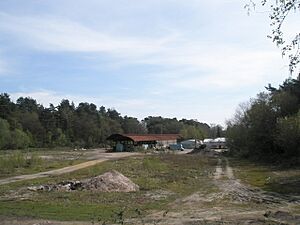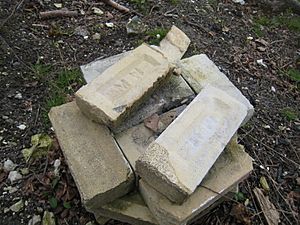Midhurst Brickworks facts for kids
|
Trade name
|
Midhurst Brickworks |
|---|---|
| Traded as | Midhurst Whites |
| Industry | Brick manufacture |
| Founded | 1913 |
| Defunct | 1985 |
| Headquarters | |
|
Key people
|
Lord Cowdray Benjamin Cloke |
The Midhurst Brickworks was a factory that made bricks. It was located near Midhurst, West Sussex, in England. The factory was built close to the old Midhurst Common railway station.
The brickworks started in 1913 on land owned by the Cowdray Estate. It closed down in 1985. After 1938, the company became known as Midhurst Whites. This name came from their main product: special white bricks made from sand and lime. The lime came from the Cocking Lime Works, about 5 kilometers (3 miles) south.
Contents
History of the Brickworks
The brickworks began in 1913. It was started by S. Pearson & Son, a company owned by the Cowdray family. Lord Cowdray owned the land. S. Pearson & Son were engineers who built big projects. They worked on places like Dover Docks and the Blackwall Tunnel in London. They also built tunnels in New York and docks in Mexico.
At first, sand for the bricks came from a pit nearby on Midhurst Common. The brickworks closed for a while after the First World War. In 1925, two men, Robert Dunning and Eli Searle, bought the factory. They had also bought the Cocking Lime Works the year before. Dunning was a brick-maker from Wales. He improved the factories at Midhurst and Cocking. This allowed the lime works to make very fine lime for brick-making.
In 1926, Benjamin Cloke bought both the brickworks and the lime works. The company was then called Midhurst Brick & Lime Co. Ltd. Cloke spent a lot of money to make the factories bigger. At the brickworks, a tall chimney, 25.9 meters (85 feet) high, was built. He also bought new machines, like an excavator and a small train engine. Two new brick presses and two large machines called autoclaves were also added. An autoclave uses heat and pressure.
Cloke hoped to get a big contract to supply bricks to London. But the deal didn't happen. He had made 4 million bricks especially for this contract. He had to sell them cheaply to a local builder. These bricks were used to build new homes in Midhurst.
The company then focused on making sand-lime bricks. To make these, damp sand and slaked lime were mixed. The lime made up about 8% of the mix. This mixture was then pressed into molds. After that, the bricks were heated under pressure in the autoclaves. The autoclaves were about 2.5 meters (8 feet) wide and 12 meters (39 feet) long. A small railway track inside allowed bricks to be moved in on special wagons. The fine lime came from the Cocking lime works.
In 1935, Cloke introduced the Midhurst White facing brick. These bricks were a cheaper choice than expensive glazed bricks. He spent a lot of money on advertising them. He sold the new white bricks for £5 per thousand. Traditional glazed bricks cost £30 per thousand. The advertisements said the bricks would stay "fresh and beautiful" and "give back the sunlight year after year."
The company quickly became very successful. It made a profit of over £1,000 every week. In 1938, the company changed its name to Midhurst Whites. Benjamin Cloke tried to sell shares of the company to the public. This didn't go as planned, but Cloke still owned many shares. This stopped the sale from being a complete failure. Soon after, Cloke passed away.
To handle more bricks, new storage buildings were built near the railway station. The Southern Railway provided 150 special containers. These containers helped transport the bricks easily.
The factory kept making bricks during World War II. They even had contracts to supply bricks to the War Office. By 1945, the company had 8 million bricks stored. The railway closed in 1964, so bricks were then transported by road. At the same time, the company expanded the factory. They even opened a new sand pit by crossing over the old railway line.
The Midhurst Brickworks finally closed its doors in 1985.
How Bricks Were Made
The sand for the bricks came from pits on Midhurst Common. These pits were very close to the brickworks. A large machine called a Ruston steam navvy dug out the sand. The sand was then loaded into small wagons. A small engine pulled these wagons to the factory.
At the factory, the sand was cleaned. Then it went into large mixing drums. Here, it was mixed with chalk from Cocking and water. The mixing took about 30 minutes. After mixing, the wet sand and lime went through a grinding machine. Then, it was sent to the brick presses.
There were two main presses that made bricks. They squeezed each pair of molds with 100 tons of pressure. These presses could make 2,800 bricks every hour! There was also a German-made press that made 1,200 bricks per hour.
The newly shaped bricks were then put onto special wagons called bogies. These bogies carried the bricks into the autoclaves. There were six autoclaves, and each could hold 13 bogies. Steam was then pumped in from a large Lancashire boiler. This steam was very hot and under high pressure. This steaming process lasted for 12 hours. After this, the finished bricks were moved by the factory's railway system. They went either to storage sheds or to the railway station for shipping.
The Works Railway System
The brickworks had its own small railway system. It had three different lines, each with a track width of 2 feet 6 inches (76 cm). The railway operated on three levels:
- The lower level connected the brick-making machines to the storage sheds and the main railway station.
- The middle level went to the sand pits.
- The upper level carried waste materials back to fill up old pits.
On the lower level, the tracks were quite complex. They connected the brick-making areas to two storage sheds and the main railway goods depot. In 1964, two small train engines worked on this level. One was a Hudson "Go-Go" engine built in 1932. This engine is now on display at the Amberley Museum Railway. The second engine was a Simplex petrol engine.
The middle level was used to bring sand from the active sand pits to the brick-making machines. Another Simplex petrol engine worked on this level. This engine can now be seen at the Old Kiln Light Railway.
The upper level was for carrying waste from the brick-making process. This waste was used to fill in old, unused pits. A third Simplex petrol engine operated on this level. This engine is now at the Apedale Valley Light Railway in Staffordshire.
About the Midhurst White Brick
The Midhurst White brick was special. However, it didn't always hold up well in bad weather, especially near the coast. Because of this, houses built with them sometimes needed to be covered with render (a type of plaster).
Even so, these bricks were very strong. They could hold heavy weights without breaking, much better than regular "red" bricks. In 2012, a plan for the Midhurst area said these bricks were "not attractive." They preferred the look of traditional red bricks.
Despite this, Midhurst White bricks were used in some famous buildings. They were used in the light wells of Battersea Power Station. They were also used at Broadcasting House (the BBC headquarters) and the main building of the Royal Institute of British Architects.



